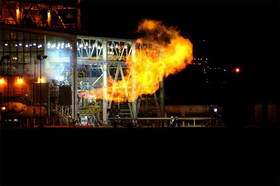Ignition Test of Technology Demonstrator Engine for Future Launch Vehicles a Success

An engine developed to demonstrate advanced rocket technologies for future launch vehicles was successfully ignited April 28 at 9:10 p.m. CDT during its test firing at NASA's Stennis Space Center near Bay St. Louis, Miss.
The initial tests on the engine, known as the Integrated Powerhead Demonstrator (IPD), were conducted at the Stennis Center's E-1 test stand. The purpose of the test series was to demonstrate the feasibility and benefits of the full-flow, staged combustion rocket engine cycle, and to demonstrate advanced engine component technologies.
The demonstrator engine test lasted 4.9 seconds. This was the third of 22 planned static ground tests of the engine.
The IPD project is the first of three phases of the Department of Defense's Integrated High Payoff Rocket Propulsion Technology Program, which is aimed at demonstrating technologies that double the capability of state-of-the-art cryogenic booster engines. The project's goal is to develop a full-flow, hydrogen-fueled, stage combustion rocket engine.
This phase one demonstrator engine employs dual preburners that provide oxygen-rich and hydrogen-rich staged combustion. The innovative system is expected to keep engine components cooler during flight. Lowering component temperatures could provide higher engine reliability and longer life, while still maintaining the highest system efficiency attainable.
While attaining the desired objectives for the Integrated High Payoff Rocket Propulsion Technology Program, the IPD engine tests also will demonstrate many component technologies directly applicable to the goals of NASA's Exploration Systems Mission Directorate. The component and system level technologies found in the Integrated Powerhead Demonstrator engine also could dramatically increase launch safety and system reliability, and reduce the cost of future space transportation systems.
NASA's Exploration Systems Mission Directorate in Washington and the Department of Defense's Integrated High Payoff Rocket Propulsion Technology Program are jointly developing the Integrated Powerhead Demonstrator. The project is being managed by the U.S. Air Force Research Laboratory (AFRL) at Edwards Air Force Base in Calif., in cooperation with NASA's Marshall Space Flight Center in Huntsville, Ala.
The demonstrator engine is a research and development activity intended to deliver advanced propulsion technologies. The engine's unique component technologies have been produced by industry partners, Aerojet and Rocketdyne. The technologies developed will benefit many Department of Defense space-access programs, as well as NASA's goal to power future missions to the Moon and beyond -- cornerstones of the Vision for Space Exploration. The Vision seeks to expand human and robotic exploration of the Solar System.
Source: NASA
















